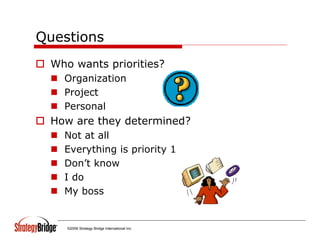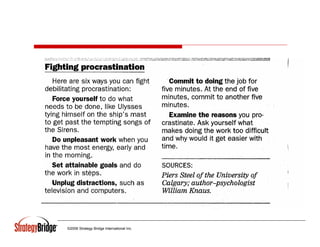Manzer fred
- 1. Managing Priorities in a Complex Environment Frederick J. Manzer fmanzer@strategybridgeintl.com 540.845.0309 ©2006 Strategy Bridge International Inc.
- 2. Phone Call Answer What should I do? Ignore Turn it off If it is my wife? My boss? My customer? The Administrator? The President? ©2006 Strategy Bridge International Inc.
- 3. Questions Who wants priorities? Organization Project Personal How are they determined? Not at all Everything is priority 1 Don’t know I do My boss ©2006 Strategy Bridge International Inc.
- 4. Typical Solutions Multi-task Task swap Do the most urgent first Worry All of the above ©2006 Strategy Bridge International Inc.
- 5. How usually decide what to do? FIFO LIFO Source Squeaky wheel Personal preference Important Urgent ©2006 Strategy Bridge International Inc.
- 6. 1st should be #1? Is it the most: Important? Urgent? ©2006 Strategy Bridge International Inc.
- 7. Determine Importance The 100 year test The “who” test The “me” test ©2006 Strategy Bridge International Inc.
- 8. Determine Urgency How long can it wait? ©2006 Strategy Bridge International Inc.
- 9. A Process Always start with what is important Criticality to the recipient Number of people impacted Long term effect Available alternatives Make a plan to get it done! List important tasks in order of priority Budget time to accomplish the tasks Each day / week / month as appropriate Work to the budget ©2006 Strategy Bridge International Inc.
- 10. Prevent Interruptions What would happen if: In a meeting On vacation With the boss Sick What is important enough to not be interrupted? By anything By some things By everything ©2006 Strategy Bridge International Inc.
- 11. Note: Interruptions can be the job: Manager Customer support Nurse Mother Still need to decide what to do first! ©2006 Strategy Bridge International Inc.
- 12. Define what creates “Urgency” How was the deadline set? How often does it change? Who decided? How is it communicated? What happens if it does not get done Then? At all? ©2006 Strategy Bridge International Inc.
- 13. Define Communication Methods How do urgent and important tasks get communicated? How can urgent and unimportant tasks be ignored? Note: the mode of communication does not by itself create urgency! Communicate your process! ©2006 Strategy Bridge International Inc.
- 14. Look at your important list: Evaluate urgent items in terms of their importance Must be urgent and important for priority Seek alternative solutions Don’t know about it Don’t do it Let someone else do it Accomplish within the free time left after doing the important ©2006 Strategy Bridge International Inc.
- 15. Don’t Multi-Task It dilutes accomplishment It is not effective – productivity goes down It satisfies neither the important nor the urgent Too much time lost in transition 10-15 minutes to recover ©2006 Strategy Bridge International Inc.
- 16. Gerri Willis top 5 tips 1 – Use minutes wisely 2 – Close your e-mail in-box Multi-tasking does not work – do sequentially 4 – Reduce desk clutter 5 – Put your schedule in writing – consolidated in one place and follow it 6 – Do hard stuff first ©2006 Strategy Bridge International Inc.
- 17. ©2006 Strategy Bridge International Inc.
- 18. Summary Priority Management is hard EGO Unreasonable bosses / customers / etc. Too much to do Someone may be unhappy! Failure to control does not equate to inability to control! ©2006 Strategy Bridge International Inc.

















